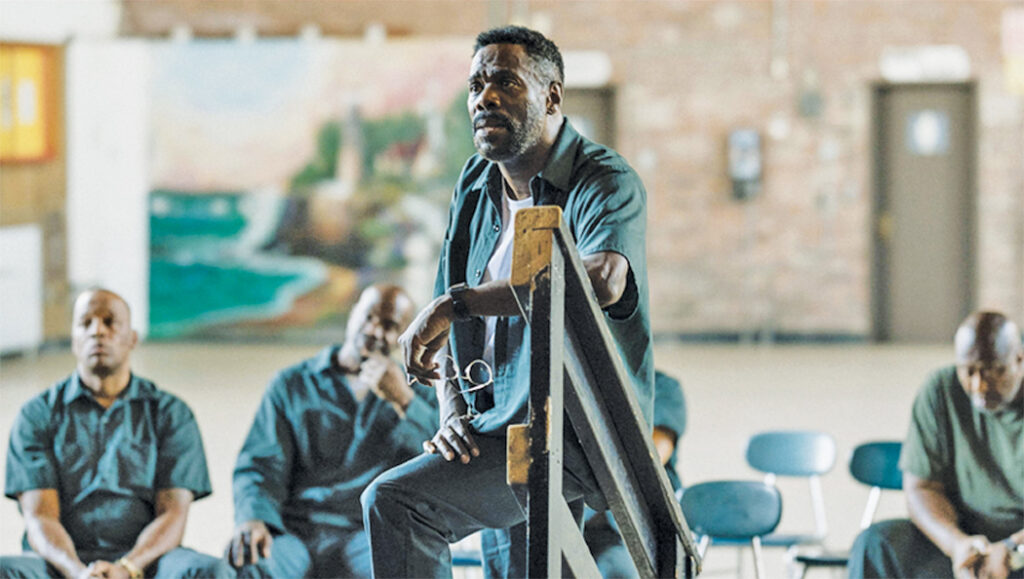
“What you will see here tonight is entertainment, but what I see is rehabilitation.” —Brian Fischer, Former Commissioner of NY State Department of Corrections
A cast of inmates performing Shakespeare for the rest of the prison population is not the way we imagine inmates spending their days. But, in fact, an experimental theater program is being incorporated at the New York state prison called Sing Sing, giving prisoners a healthy outlet that seems to offer some therapeutic results. The film Sing Sing is a fictionalized tale about this very real program, featuring some of the actual participants who have since completed their prison sentences and were cast in the movie.
As Sing Sing suggests, there’s a lot to be learned about how the arts affect the performers as well as the audience, whether the material is classic Shakespeare, science fiction, or comedy. The film gives us a vision of how the prisoners are trained to step outside of their own identity to take on the role of a character. And as it turns out, becoming someone else offers a constructive side effect. The actor gains a clearer vision of himself.
But first let’s unravel the title. Sing Sing is the original name of the village of Ossining, located thirty miles north of Manhattan. The name is derived from the Native American phrase sint sinck, meaning “stone upon stone,” referring to the village’s native marble that constructed the state correctional facility for men in 1825. The compound, which was built by prisoners, still bears the name Sing Sing.
Sing Sing, the movie, tips its hat to the master minds of this theater program, Rehabilitation Through the Arts. RTA was founded by Brent Buell in 1996 following a few successful theater productions by a group of incarcerated men. Its success was a positive experience that gave participants a sense of purpose, enjoyment, achievement, and even hope. And most importantly, meetings for auditions, rehearsals, and coaching are the antithesis of the prison routine. Theater offers a creative outlet that inmates look forward to, where they can let down their guard, explore something meaningful (including their own emotions), and most of all, spend a sanctioned part of their day feeling human. Numerous U.S. prisons have experimented with performance training as a tool for self-discovery, which is a nod to the opening quote from the former Commissioner about that long-abandoned concept of rehabilitation.
The mostly amateur cast members of Sing Sing are previous inmates in the theater program whose delivery is far beyond satisfying. As we get to know these characters, we learn about them as people with lives beyond the prison walls. And scenes of rehearsals, auditions, and performances reveal that prisoners have an instinct for inhabiting the roles of other characters. The act of being someone else gives them the freedom to step outside of themselves, which leads to inner discovery. If this can happen in prison, it can happen anywhere.
A former inmate named John “Divine G” Whitfield is not in the film but is played by the actor Colman Domingo. Domingo leads the film with mastery in his role as Whitfield, the inmate who spends his days in the prison law library, researching legal loopholes that could reverse his conviction.
And then there is Brent Buell, the actual RTA organizer at Sing Sing. Buell is played by film and TV actor Paul Raci. Raci is fabulous, and so convincing I assumed he was the real acting coach.
Many programs find their way into correctional facilities, each with its own method and goal. Some offer group counseling, where inmates talk about why they commit crimes. Some teach inmates employable skills for their release. The theater program offers something unique. Participants seem to gain a positive outlook and the motivation to lead a productive life when they return to the world beyond the prison’s marble walls.
Kudos to Sing Sing director Greg Kwedar, who brought out the genuine best in each cast member. Kwedar also co-wrote the screenplay along with John H. Richardson, Clint Bentley, and theater coach Brent Buell. We’ll close with a statement from Buell, who was interviewed earlier this year on the National Public Radio program 1A:
“In this country, the attitude of prison is punishment. And what I want people to think about is in almost every case, people are gonna be returning back to society when they finish their sentence. What kind of person do you want returned to you? Do you want a person who has just sat under a punishment for all those years, or do you want someone who’s really been given tools to become a full human being again? And for very little money, for very little change in how things are done, these programs could be in every prison. When a person takes on a role, you have to step into another character. You have to see through that character’s eyes. And that is a revelation to people, to start thinking, how does this person see. And it’s the beginning of empathy.”
